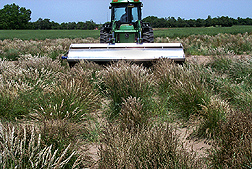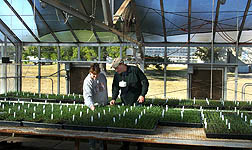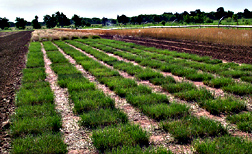In Search for Better Forage Grasses for the Southern Plains
|
|
In what’s already been a fruitful pursuit, ARS scientists are looking near and far in studies aimed at breeding forage grasses that can thrive in the southern Great Plains.
So far, rangeland scientist Phillip Sims, agronomist Tim Springer, and plant geneticist Jason Goldman at ARS’s Southern Plains Range Research Station in Woodward, Oklahoma, have released two important new grass varieties, developed a new molecular-based way to screen eastern gamagrass that may help boost its seed production, and started an evaluation nursery for crosses featuring Texas bluegrass.
“Our goal is to develop grasses, both warm-season and cool-season, that’ll let the region’s livestock graze on nutritious forage year round,” says Sims, who is the station’s research leader. “We want to increase seed and forage production, persistence, and quality within grazing systems.”
A key goal of this work is production of forage grasses that can live long on highly erodible lands and complement native rangeland. “We need efficient grazing methods that help maintain or improve plant, soil, water, wildlife, and aesthetic resources,” Sims says.
Factors that hamper southern Plains livestock production include low forage quality from late summer through winter, dry weather, weeds, and overuse of land. Overcoming them has proven to be a tough task.
|
|
“We’ve tested just about every cool-season grass from around the world here,” says Sims. “Many of them have generally done well, except for one thing: They can’t survive the area’s extended dry periods.”
Insects and diseases are also major challenges. “This is especially true with eastern gamagrass, which is susceptible to threats common to maize,” says Springer.
The current Woodward program revolves around two warm-season grass species—eastern gamagrass (Tripsacum dactyloides) and sand bluestem (Andropogon hallii)—and a cool-season variety, Texas bluegrass (Poa arachnifera). All three are native to the southern Plains, but each has drawbacks that affect its usefulness.
Eastern gamagrass, long recognized as a productive and palatable forage grass, is limited by low seed production, inferior seed quality, and establishment and persistence difficulties. “But its ability to grow on a range of soils and tolerate drought and flooding has long made it an integral part of our research,” says Springer. “We love its potential for increased forage production in summer.”
“It’s particularly useful on sites along streams and creeks that are difficult to farm but have access to water that permits this species to grow rapidly,” adds Sims.
Verl and Chet
In 2005, the Woodward station released an important new eastern gamagrass called “Verl.”
“It’s the first gamagrass released that was selected from a hybrid breeding program,” Springer says. “It has a known pedigree. That’s a first.” He explains that past gamagrass varieties have been developed from wild populations.
In field trials, Verl equaled or surpassed standards set by a highly productive gamagrass called “Pete,” released in 1988. “In testing in Kansas, Oklahoma, Texas, Mississippi, Florida, and New York, Verl’s forage dry matter yield was an average of 11 percent greater than Pete’s,” says Springer. “Also, in an experiment at Woodward, it produced 45 percent more seed than Pete.”
Verl was released in cooperation with the Oklahoma Agricultural Experiment Station (OAES) and USDA’s Natural Resources Conservation Service (NRCS).
|
|
The eastern-gamagrass work has paid off on the molecular-studies front as well. Goldman has developed a way to use high-throughput DNA extraction and allele-specific polymerase chain reaction primers to quickly and efficiently screen for a potentially useful seed-increasing trait. He and colleagues designed specific primers that detect a key mutation that can help increase seed production 10- to 20-fold, compared to the common wild-type gamagrass.
Springer, meanwhile, was a driving force behind a new sand bluestem variety called “Chet,” which was also released in cooperation with OAES and NRCS.
Sand bluestem is lauded for its forage palatability, high yield, and positive ecological impact. Its creeping underground stems make it tolerant to reasonably heavy grazing.
Springer says that Chet’s forage dry matter yield was almost 9 percent greater than that of a key sand bluestem variety called “Woodward,” developed there during the 1950s. “And it produces growth of about 2.5 pounds a day on stocker cattle over a 62-day grazing period.”
A Bluegrass Revolution?
Goldman and Sims are looking to create useful hybrids for the southern Plains by cross-breeding Texas bluegrass with other bluegrass species and with bluegrasses from other regions.
“Texas bluegrass has withstood the region’s heat and droughts for centuries, but the seed is difficult to harvest and plant, and it’s susceptible to diseases such as leaf rust,” says Goldman. “Our work can result in novel forage or in low-input, turf-type material.”
Sims explains that a perennial, cool-season forage grass would be an economical, environmentally friendly, and sustainable alternative to using wheat as cool-season forage.
Goldman has established an evaluation nursery using genetic material from Texas, Canadian (P. compressa), Kentucky (P. pratensis), Argentine (P. ligularis), and Sandberg (P. secunda) bluegrasses.
Though their work has not yet led to release of a new variety, Sims and Goldman have produced more than 80 hybrid types, many of which are complex hybrids involving three different species.
In addition, they’re intrigued by crosses developed by late Woodward scientist Chet Dewald using Texas and Argentine bluegrasses. “Both species are native to arid environments and are highly palatable to herbivores,” Sims says. “And both come from similar latitudes within their hemispheres.”
Two of these crosses produced more than 200 seeds each. “And seeds harvested from the hybrids lost the undesirable cottony characteristic of Texas bluegrass seeds,” says Goldman.
He adds that the cross-species forage hybrids he’s examining also have potential for use as turf.
“The Argentine variety has a fine-leaf trait. Kentucky bluegrass has the color and density desired for turf, the Canadian type is more of a turf type to begin with, and Texas bluegrass can contribute heat and drought tolerance to turf and has a wider geographic range of use.”—By Luis Pons, formerly with ARS.
This research is part of Rangeland, Pasture, and Forages, an ARS national program (#205) described on the World Wide Web at www.nps.ars.usda.gov.
Phillip L. Sims (now retired), Jason Goldman, and Tim L. Springer are with the Southern Plains Range Research Station, 2000 18th St., Woodward, OK 73801; phone (580) 256-7449, fax (580) 256-1322.
"In Search for Better Forage Grasses for the Southern Plains" was published in the January 2008 issue of Agricultural Research magazine.










